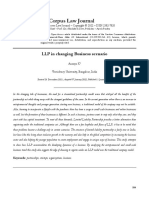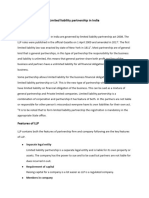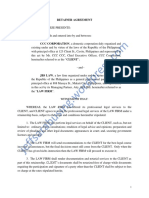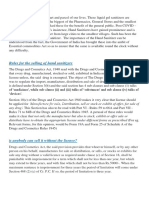PANJAB UNIVERSITY REGIONAL CENTRE,
LUDHIANA
ASSIGNMENT OF BUSINESS LAWS-I
“LLP VS TRADITIONAL PARTNERSHIP
PARTNERS AND THEIR RELATIONS IN LLP”
SUBMITTED TO- SUBMITTED BY-
DR. RAJANI BAGGA SAANCH
B.A.LL.B. (7th SEM)
ROLL NO. – 63/20F
1|Page
� INDEX
S.NO. TOPIC PAGE REMARKS
NO.
1 Acknowledgement 3
2 Meaning, Nature and Features of Limited 4-5
Liability Partnership (LLP)
3 Need for LLP 6-7
4 Difference between LLP and Partnership 8-10
5 Kinds of Partners and Their Relationship, 11-13
Mutual Rights and Cessation of Partnership
Interest
6 Chapter IV: Partners and their Relations 14-17
7 Chapter V: Extent and Limitation of Liability 17
of Limited Liability Partnership and Partners
8 Conclusion 18
9 Bibliography 19
2|Page
� Acknowledgement
I would like to express my special thanks of gratitude to Dr. Aman Amrit Cheema,
our Director, P.U.R.C., Ludhiana, and my teacher, Dr. Rajani Bagga who gave me
this wonderful opportunity to do this wonderful project on the topic,
"LLP VS TRADITIONAL PARTNERSHIP AND PARTNERS AND THEIR RELATIONS IN
LLP" which also helped me in doing a lot of research and I came to know about
many novelties.
Secondly, I would also like to thank my family and friends who helped me a lot in
finishing this project within the time limit.
- SAANCH
B.A.LL.B (7th SEM)
ROLL NO. -63/20F
3|Page
�Meaning, nature and features of
limited liability partnership (llp)
Meaning, Nature and Features of Limited Liability Partnership (LLP) We can say that
Partnership' or LLP is derived from the concept of partnership. the concept of 'Limited
Liability LLPS offer a balance between entrepreneurial freedom and unlimited liability.
Main Features:
1. Body Corporate and Separate Legal Entity
An LLP is a body corporate and it is mandatory that it be registered with the
Registrar of Companies (earlier, Registrar of LLP). An LLP is a distinct separate legal
entity from its partners. It has perpetual succession.
2. Membership and Management
Membership of an LLP is open to all legal persons, but there is a prescribed
minimum number of members i.e., 2 members. There is no upper limit.
The law requires that there must be 02 designated partners, one of whom is an
Indian Resident. Designated partners are required to undertake the formalities
under the 2008 Act. If no such designation is made, then all partners are treated as
designated partners.
3. Structure and Capacity
An LLP can be engaged in any lawful business. It is not bound like companies that
have to operate within the parameter of their Memorandum of Association
(MoAs). Partners have the discretion to conduct and manage the business as they
deem appropriate. Further, the relationship between the partners is determined
4|Page
�by their agreement with one another and in the absence of such an agreement, the
2008 Act governs the same.
4. Liability
While an LLP is liable to the extent of its assets, the partners are liable only to the
extent of their contribution in the LLP. Thus, personal assets of the individual
partners are protected from liability.
5. Investigations
The Act empowers the Central Government to investigate LLPS.
6. Conversion
The 2008 Act provides partnership firms, private companies and unlisted public
companies with the opportunity to convert themselves into an LLP.
7. Finances and Taxation
An LLP is required to maintain annual accounts and is subject to audits unless
exempted buy the Central Government Returns and annual accounts have to be
submitted to audits unless exempted by the Central Government Returns and
annual accounts have to be submitted to the Registrar of Companies.
5|Page
� Need for LLP
Mercantile endeavors require an appetite for risk and innovation along with the
capacity to handle the losses, if any. In the present day, there is much stricter scrutiny
on violations of laws and regulations, misappropriation of funds and other breaches.
Further, access to information and justice has led to a more pro-active clientele willing
to approach courts for dispute resolution.
In such a situation, it is clear that limited liability is preferable to allow greater
competitiveness in the markets without sacrificing rule of law. The concept of 'limited
liability' provides that the (financial) liability of a person in a business
organization/activity in which he is engaged is limited or capped to the extent of his
investment in the said organization or activity. Thus, the personal assets of such a
person are not liable towards the liabilities of the organization he is a part of.
II. Historical Background The idea of limited liability is not a new one. And
efforts to limit liability are not limited to mercantile or commercial law. For instance,
the head of the family was responsible for the torts of his issues under Roman law. But
he also had the option of turning over the person of his child to satisfy the liability. The
concept of 'peculium' was a straighter forward attempt to limit liability in transactions.
Similar application of limited liability can also be traced back to Arabic transactions
wherein a merchant and an investor would enter into an agreement to share profits
from trade/business. The investor would provide money for the merchant to enter
into transactions, but the merchant was protected from any liability.
From the 15th century onwards, different 'societies in accomandite' started
appearing all over Europe. These also served as the template for the early statutes
concerning limited Within the Indian context, the evolution of LLPs can be
partnerships in the US.
Within the India context, the evolution of LLPs can be traced as follows:
6|Page
� (a) Law Commission of India Report (1957). It rejected a proposal to introduce
limited liability due to concerns about peculiar conditions in India and the
impact such LLPs would have on the Indian Companies Act-which had been
recently been amended for stricter provisions. Committees also recommended
the
(b) Multiple introductions of limited liability whether for small-scale endeavours,
professionals or others, citing benefits of increased capital investment, need to
protect investors in venture capital funds, encouraging growth of professional
firms to international competition, etc.¹
(c) J.J. Irani Expert Committee (2005). Set up the Ministry of Company Affairs, the
Committee reiterated the recommendation for incorporation of limited liability
in India and suggested a separate law for the same. It emphasized a holistic
introduction of the idea for small scale enterprises, professional firms, etc.
Post the J.J. Irani Expert Committee, the Government of India released a concept
paper on 'Limited Liability Partnership and paved the way for a bill on the subject.
Thus, the Irani Committee is credited with the enactment of the Limited Liability Act,
2008.
7|Page
� Difference between
LLP and Partnership
Partnership LLP
Governing Law Indian Partnership Act, 1932 The LLP Act, 2008 and
and various Rules made various Rules made
thereunder thereunder
Conception Creation of contract Creation of Law
Registration/ Authority Optional/ Before Mandatory. AN unregistered
LLP will be considered a
partnership under the
Partnership Act, 1932 if it
meets the requirements of
the Act/Before Registrar of
Companies
Separate Legal Entity No distinct legal entity exists A distinct legal entity exists
under as there are elements
of ‘body corporate’
Name Ant name as per choice of Name contains the word
partners “Limited Liability
Partnership’ or ‘LLP’ as
suffix.
Agreement/Contract May or may not be written. Has to be in writing. Public
Private Document Document.
Perpetual Succession No, as its existence depends It has perpetual succession
on the will of the partners or and may come and go.
the agreement between
them.
8|Page
�Founding/Charter Document ‘Partnership Deed’ LLP Agreement
Common Seal There is no concept of LLP may have its own
common seal. common seal, as per the LLP
agreement
Legal Proceedings Only registered partnership An LLP is a legal entity that
can sue third party that can sue and be sued
Foreign Participation Foreign Nationals cannot Foreign Nationals can be a
form partnership firms in Partner in LLP
India
Minimum Number of It requires minimum 2 It requires minimum w
Members/ Partners partners to start. partners, and one of them
must be an Indian resident
Maximum Number of Maximum 50 at present There is no limitation of
Members/ Partners maximum number of
partners in LLP
Liability The liability of the partner is The liability of a partner is
unlimited and includes his limited to his contribution,
personal assets. Thus, it is a unless it concerns
joint, several and unlimited. intentional fraud or
wrongful acts.
Business It can engage in any lawful It can engage in proposed
business as long as the business mentioned in the
partners agree to the same. incorporation document
Property Property of the firms is the The property of the LLP
joint property of all the belongs to the LLP and not
partners the partners
Agent There is mutual agency- Partner in an agent of LLP,
every partner in a not other partners.
partnership is an agent of
the other partners.
9|Page
�Management Every partner is entitled to All partners are entitled to
take part in the take part in the business
management of the firm’s unless agreement to the
business contrary. Further, the Act
provides for ‘Designated
Partners’
Transfer of Interests A partner cannot transfer his Transferable, subject to
interest without the consent agreement.
of all other partners, unless
there is a contract to the
contrary
Dissolution and Winding Up It is dissolved by death or It can be dissolved
insanity of a partner. A voluntarily or by an order of
partnership can be dissolved the NCLT.
by agreement, mutual
consent contingencies like
insolvency and by court
order.
Audit Audit is not compulsory There is an obligatory audit
of the accounts unless
exempted by the Central
Government vide a
notification. Also, contains
provision for whistle-
blowing.
10 | P a g e
�Kinds of Partners and Their
Relationship, Mutual Rights and
Cessation of Partnership Interest
The Indian Partnership Act, 1932 does not apply to LIPs except as provided by the 2008
Act.' The LLP Act, 2008 also provides its own definition of a partners. S. 2(q) provides
that partner' in relation to a limited liability partnership refers to "any person who
becomes a partner in the limited liability partnership in accordance with the limited
liability partnership agreement"
As stated earlier, any individual or body corporate can become a partner in an LIP' But
the proviso to S. 5 places certain restrictions such as a person should not: -
(a) have been found to be of unsound mind by a Court of competent jurisdiction,
(b) be an undischarged insolvent, or
(c) have applied to be adjudicated as an insolvent and his application be pending.
Every LLP is required to have at least two partners. If there are less than 02 partners
and the LLP continues with its business for more than 06 months in such a scenario, the
sole partner (carrying on the busine with son knowledge that be alone is running the
business) will be personally liable for l to obligations that the LLP incurs during such
period.
11 | P a g e
�Designated Partners
The Act also introduces the concept of designated partners! It requires
every LLP to have at least 02 designated partners who are individuals and one of whom
has to be an Indian resident.' If all LLP partners are body corporates or there is a mix of
individuals and body corporates, 02 who are partners d such LLP or nominees of such
bodies corporate shall act as designated partners. Conditions and requirements may be
prescribed for eligibility to be a designated partner. It is also mandatory for designated
partner to obtain a Designated Partner Identification Number (DPIN).
While it is open for the LLP's incorporation document to specify certain partners to be
designated partners, the same may be done through the LLP agreement too. In all
circumstances, an individual has to give prior consent to being a designated partner The
consent also has to be registered with the Registrar withs 30 days of the concerned
individual being appointed.
If a vacancy arises, the LLP can appoint another designate partner within 30 days of the
vacancy arising. If no designated partner is appointed, or if at any time there is only one
designated partner, designated partner. each partner shall be deemed to be a
designated partner.
Designated partners are:
(a) responsible for the doing of all acts, matters and thing are required to be done
by the limited liability partnership in respect of compliance of the provision
statement of this Act including filing of any document, return, the like report
pursuant Provisions of this Act may be specified in the limited liability
partnership agreement;
(b) liable to ill penalties imposed on the limited liability partnership for any
contravention of those provisions. If designated partners are not appointed,
their consent is pot registered with the Registrar or if the designated partners fail
12 | P a g e
� (c) to fulfil their obligations under S. 9, the LLP and each partner therein can be
financially penalized with further provisions for continuing offences.
LLP Agreement and LLP Incorporation
S. 11 talks about the incorporation document. It requires that 02 or more two or more
persons associated for carrying on a lawful business with a view to profit subscribe their
names to an incorporation document and file the same in prescribed format with due
fees before the concerned State's Registrar. Along with the incorporation document, a
statement by either an advocate, I a Company Secretary or a Chartered Accountant or a
Cost Accountant (who is engaged in the formation of the LLP) and by anyone who
subscribed his name to the incorporation document as to compliance with the Act and
rules thereunder must also be fled. Statements known to be false or not believed to be
true in be penalized imprisonment of up to 02 years and minimum fine of Rs. 10,000/-
that can be extended up to Rs. 5 Lakh.
Publication of the name and limited liability: -
1. Every limited liability partnership shall ensure that its invoices, official
Correspondence and publications bear the following, namely: -
(a) the name, address of its registered office and registration number of the
limited liability partnership, and
(b) a statement that it is registered with limited liability.
2. If the limited liability partnership contravenes the provisions of this
section, the limited liability partnership shall be liable to a penalty of then
thousand rupees.
13 | P a g e
�CHAPTER IV PARTNERS AND THEIR RELATIONS
Eligibility to be partners. - On the incorporation of a limited liability partnership, the
persons who subscribed their names to the incorporation document shall be its
partners and any other person may become a partner of the limited liability partnership
by and in accordance with the limited liability partnership agreement.
Relationship of partners. —
(1) Save as otherwise provided by this Act, the mutual rights and duties of the partners
of a limited liability partnership, and the mutual rights and duties of a limited liability
partnership and its partners, shall be governed by the limited liability partnership
agreement between the partners, or between the limited liability partnership and its
partners.
(2) The limited liability partnership agreement and any changes, if any, made therein
shall be filed with the Registrar in such form, manner and accompanied by such fees as
may be prescribed.
(3) An agreement in writing made before the incorporation of a limited liability
partnership between the persons subscribe their names to the incorporation document
may impose actions on the limited liability partner, provided such agreement is ratified
by all the partners after the incorporation of the limited liability partnership.
(4) In the absence of agreement as to any matter, the mutual rights and duties of the
partners and the mutual rights and duties of the limited liability partnership and the
partners shall be determined by the provisions relating to that matter as are set-out in
the First Schedule.
Cessation of partnership interest.
(1) A person may cease to be a partner of a limited liability partnership in accordance
with an agreement with the other partners or, in the absence of agreement with the
14 | P a g e
�other partners as to cessation of being a partner, by giving a notice in writing of not less
than thirty days to the other partners of his intention to resign as partner.
(2) A person shall cease to be a partner of a limited liability partnership: -
(a) on his death or dissolution of the limited liability partnership; or
(b) if he is declared to be of unsound mind by a competent court; or
(c) if he has applied to be adjudged as an insolvent or declared as an
insolvent.
(3) Where a person has ceased to be a partner of a limited liability partnership
(hereinafter referred to as "former partner"), the former partner is to be regarded (in
relation to any person dealing with the limited liability partnership) as still being a
partner of the limited liability partnership unless:
(a) the person has notice that the former partner has ceased to be a
partner of the limited liability partnership; or
(b) notice that the former partner has ceased to be a partner of the
limited liability partnership has been delivered to the Registrar.
(4) The cessation of a partner from the limited liability partnership does not by itself
discharge the partner from any obligation to the limited liability partnership or to the
other partners or to any other person which he incurred while being a partner.
(5) Where a partner of a limited liability partnership ceases to be a partner, unless
otherwise provided in the limited liability partnership agreement, the former partner or
a person entitled to his share in consequence on of the death or insolvency a former
partner, shall be entitled to receive from the s liability partnership: -
(a) an amount equal to the capital contribution of a former partner
actually made to the limited its, partnership; and
(b) his right to share in the accumulated profits of the limited liability
partnership, after the deduction d accumulated losses of the limited
liability partnership. determined as at the date the former partner ceased
to be a partner.
15 | P a g e
�(6) A former partner or a person entitled to his share in consequence of the death or
insolvency of the former partner shall not have any right to interfere in the
management of the limited liability partnership.
Registration of changes in partners. —
(1) Every partner shall inform the limited liability partnership of any change in his name
or address within a period of fifteen days of such change.
(2) A limited liability partnership shall: -
(a) where a person becomes or ceases to be a partner, file a notice with
the Registrar within thirty days from the date he becomes or ceases to be
a partner; and
(b) where there is any change in the name or address of a partner, file a
notice with the Registrar within thirty days of such change.
(3) A notice filed with the Registrar under sub-section
(2) :—
(a) shall be in such form and accompanied by such fees as may be
prescribed;
(b) shall be signed by the designated partner of the limited liability
partnership and authenticated in a manner t may be prescribed;
and
(c) if it relates to an incoming partner, shall contain statement by
such partner that he consents to becoming a partner, signed by
him and authenticated in le manner as may be prescribed.
(4) If the limited liability partnership contravenes the provisions of sub-section (2), the
limited liability partnership and its every designated partner shall be liable to a penalty
of ten thousand rupees.
16 | P a g e
�(5) If the contravention referred to in sub-section (1) is made by any partner of the
limited liability partnership, such partner shall be liable to a penalty of rupees ten
thousand rupees.
(6) Any person who ceases to be a partner of a limited liability partnership may himself
file with the Registrar the notice referred to in sub-section (3) if he has reasonable
cause to believe that the limited liability partnership may not file the notice with the
Registrar and in case of any such notice filed by a partner, the Registrar shall obtain a
confirmation to this effect from the limited liability partnership unless the limited
liability partnership unless the limited liability partnership has also filled such notice:
Provided that where no confirmation is given by the limited liability partnership within
fifteen days, the registrar shall register the notice made by a person ceasing to be a
partner under this section.
Chapter v EXTENT AND LIMITATION OF LIABILITY OF LIMITED
LIABILITY PARTNERSHIP AND PARTNERS
Partner as agent. Every partner of a limited liability partnership is, for the purpose of
the business of the limited liability partnership, the agent of the limited liability
partnership. but not of other partners.
Extent of liability of limited liability partnership. (1) A limited liability partnership is
not bound by anything done by a partner in dealing with a person if: -
(a) the partner in fact has no authority to act for the limited liability partnership
in doing a particular act: and
(b) the person knows that he has no authority or does not know or believe him
to be a partner of the limited liability partnership. (2) The limited liability
partnership is liable if a partner of a limited liability partnership is liable to
any person as a result of a wrongful act or omission on his part in the course
of the business limited liability partnership or with its authority.
17 | P a g e
� Conclusion
LLPs are a hybrid-structure that combine the versatile and flexible nature of
partnerships with the limited liabilities benefits of an incorporated company- allowing
for smoother capital flows
LLPs have the immediate advantage of limiting liability when conducting business in
partnership. It provides greater impetus and protection to investors-allowing for great
capital flows. It lowers the cost and complexity of supervising the management. It
allows freedom in transfer and thus, greater likelihood of survival as well as expansion.
It retains the low cost of formation and removes mutual agency between partners-
protecting their individual interests. It is also a body corporate with its own legal
existence wherein it can sue and be sued in its own name reducing the uncertainty
and troubles that an unregistered partnership may itself face or cause to others.
But it also has the disadvantage of lowering the bar for wrongful and fraudulent
trading, which increases the burden on the authorities and third parties who deal with
LLPs. Further, it can also shift risk from shareholders to creditors
18 | P a g e
� bibliography
Avtar Singh, introduction to law of partnership
(Eastern book company, Lucknow, 11th ed, 2018)
R.k. bangia, Indian partnership act (Allahabad law
agency, Allahabad,14 ed. 2018)
th
Dsr krishnamurti, law relating to limited liability
partnership law and (Taxman publications private
limited,2010)
Statutory Materials –
The Indian Partnership Act, 1932
The Limited Liability Partnership Act, 2008
19 | P a g e



















































































